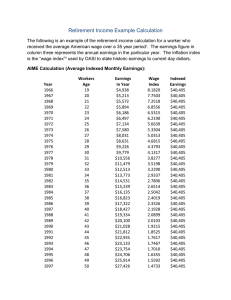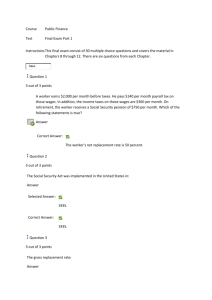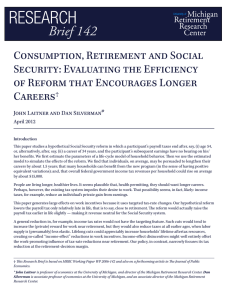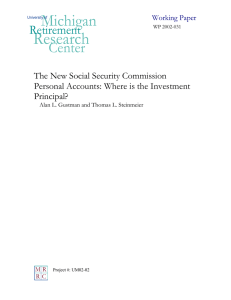Research M ichigan Retirement
advertisement
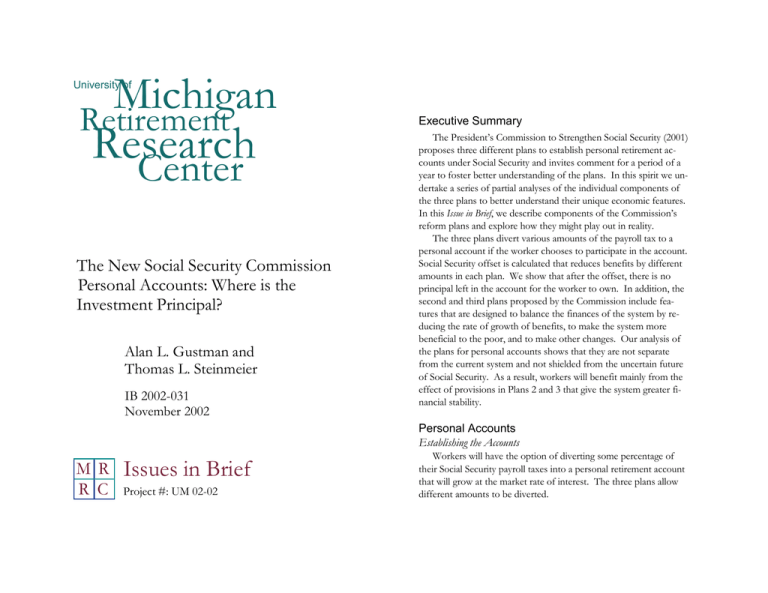
ichigan M Retirement Research University of Center The New Social Security Commission Personal Accounts: Where is the Investment Principal? Alan L. Gustman and Thomas L. Steinmeier IB 2002-031 November 2002 Executive Summary The President’s Commission to Strengthen Social Security (2001) proposes three different plans to establish personal retirement accounts under Social Security and invites comment for a period of a year to foster better understanding of the plans. In this spirit we undertake a series of partial analyses of the individual components of the three plans to better understand their unique economic features. In this Issue in Brief, we describe components of the Commission’s reform plans and explore how they might play out in reality. The three plans divert various amounts of the payroll tax to a personal account if the worker chooses to participate in the account. Social Security offset is calculated that reduces benefits by different amounts in each plan. We show that after the offset, there is no principal left in the account for the worker to own. In addition, the second and third plans proposed by the Commission include features that are designed to balance the finances of the system by reducing the rate of growth of benefits, to make the system more beneficial to the poor, and to make other changes. Our analysis of the plans for personal accounts shows that they are not separate from the current system and not shielded from the uncertain future of Social Security. As a result, workers will benefit mainly from the effect of provisions in Plans 2 and 3 that give the system greater financial stability. Personal Accounts Establishing the Accounts M R R C Issues in Brief Project #: UM 02-02 Workers will have the option of diverting some percentage of their Social Security payroll taxes into a personal retirement account that will grow at the market rate of interest. The three plans allow different amounts to be diverted. • • • Plan 1 allows 2 percent of the payroll tax to go to the personal account; Plan 2 allows 4 percent up to $1000 per year; Plan 3 allows 2.5 percent up to $1000 per year and the worker makes a voluntary contribution of 1 percent of his wages. In plans 1 and 2, the amount diverted to the personal account is “carved out” of the payroll tax. So if the payroll tax is 12%, under Plan 1, 2% can go to the personal account and 10% goes into the Social Security System. In Plan 3, the 1 percent voluntary contribution is over and above the total of the payroll tax. Reductions in Traditional Social Security Benefits The balance of the payroll tax continues to support the traditional system, and benefits are paid according to the usual benefit formula. For workers who chose to divert funds to a personal account, however, their traditional retirement benefits will be reduced. This reduction is called the offset. In general, benefits will be reduced by the exact same amount as the principal in the account plus interest that is called the offset interest. The three plans differ in the size of the offset interest figured. The first an offset interest rate of 3.5 percent, the second and third plans use 2 and 2.5 percent, respectively. So, under Plan 1, for example, a participating worker’s traditional benefits would be reduced by an amount equal to the principal in the account plus 3.5 percent interest. • minus (an amount equal to the principal in the personal account plus the offset interest). This makes it clear that the principal in the personal account does not actually count toward the worker’s retirement benefit. Us- ing Plan 1 as an example, if the market rate of interest is 3.5 percent, the worker will end up with exactly the same level of retirement benefits as he would if he had not had a personal account but had participated only in the traditional system. If, on the other hand, the market experiences high growth, the worker will have benefits that are higher by the average rate of market growth minus the offset interest. The lower the offset interest used (for example 2% in Plan 2), and the higher the interest rate in the market, the more likely it is that the worker will come out ahead. Plan 3 is different from Plans 1 and 2 in that the one percent of wages that the worker voluntarily puts in the account is not used in the offset calculation. Protection From Political Risk When people refer to political risk or uncertainty associated with Social Security, it refers primarily to the fact that benefits can be reduced by political decisions, or at the extreme, that the whole program could be shut down. What is clear from the report is the fact that the personal accounts do not shield workers from this risk. Another way to decrease political risk is to improve the health of the current system. In the next section, we describe Commission proposals that address this issue. So the worker’s retirement benefit would be: • the personal account principal plus earned market interest • plus the amount of the traditional Social Security benefit The New Social Security Commission... 2 Increasing Benefits for Low Wage Workers (Plans 2 and 3) Funding and Distributional Changes We begin by noting that these proposals are more or less independent of personal accounts: they will have the same effects whether people divert wages to personal accounts or not. In both Plans 2 and 3, the PIA for low-wage workers will be increased: under Plan 2, the PIA for 30-year minimum wage workers will be increased by more than 40%; under Plan 3, by 12%. This provision is to increase relative benefits of low-income workers. Limiting Growth of Benefits (Plans 2 and 3) Decreasing Benefits for High Wage Workers (Plan 3) The Primary Insurance Amount (PIA), or the amount of an individual worker’s benefits, is currently adjusted over time according to changes in average wages. Under Plan 2, rather than wage-adjusted, it will be inflation-adjusted. Since increases in average price levels (inflation) capture only part of what increases in average wages do (changes in average wages measure increases in productivity of average workers, as well as increases in average price levels), the PIA under Plan 2 will be adjusted at a smaller rate. Under Plan 3, the PIA will be adjusted so as to reflect increases in longevity (so it will equal the rate of inflation plus ½%). The primary effect of this provision is to bring the system back toward solvency. The PIA is currently calculated by adding 90% of the first $592 of average monthly earnings, 32% of average monthly earnings over $592 and through $3,567, and 15% of average monthly earnings over $3,567. Under Plan 3, the third PIA factor will be decreased from 15% to 10%. This change will increase relative benefits to lowincome individuals, and at the same time contribute to the solvency of the system. Modifying Actuarial Reduction and Increment Factors (Plan 3) Under the current laws, total benefits decrease by 20% for someone retiring 3 years before the NRA and 30% for someone retiring 5 years before, and benefits increase by an annual rate of 8% for delayed retirement. Under Plan 3, these percentages will be increased to 25%, 37%, and 10%. This provision is to encourage people to continue working longer, and thus improve the solvency of the system. Increasing Benefits for Low Wage Widows and Widowers (Plans 2 and 3) In both Plans 2 and 3, the benefits to surviving spouses, who would otherwise receive less than the average PIA, will be increased to 75% of the benefits that would be received by the couple if both were still alive. This change will worsen the solvency of the system but will serve a purpose that the current system does not: to keep surviving spouses out of poverty. Conclusion When personal accounts are mentioned, most people think of accounts that are in some sense separate and shielded from the uncertainties of the Social Security system. That is not the case for the personal accounts proposed by the Commission. Because the participating individual is not entitled to the principal in the account, The New Social Security Commission... 3 participating in the account does not shield the individual from the political risks of being in the Social Security system. The offset to the plan essentially taxes away the principal in the account, but leaves intact the full Social Security benefit. Any change in retirement income due to the account reflects the difference in interest earned on the personal account beyond the offset interest. Without being pejorative, we can describe the account as a financial instrument equivalent to a bet that the real return will exceed the level of offset specified in the plan, ranging from 2 percent to 3.5 percent real. As a result, the reduction in political risk fostered by the Commission’s proposals comes mainly from the improvement in the financial status of the system fostered by other provisions of the recommended plans as described. Alan L. Gustman is a Loren Berry Professor of Economics at Dartmouth College. Thomas L. Steinmeier is a Professor of Economics at Texas Tech University. Michigan Retirement Research Center Institute for Social Research University of Michigan 426 Thompson Street, Room 3026 Ann Arbor, MI 48104-2321 This work was supported by a grant from the Social Security Administration through the Michigan Retirement Research Center (Grant # 10-P-98358-5). The opinions and conclusions are solely those of the authors and should not be considered as represent ing the opinions or policy of the Social Security Administration or any agency of the Federal Government. Phone (734) 615-0422 Fax (734) 615-2180 http://www.mrrc.isr.umich.edu mrrc@umich.edu Regents of the University of Michigan David A. Brandon, Ann Arbor Laurence B. Deitch, Bingham Farms Olivia P. Maynard, Goodrich Rebecca McGowan, Ann Arbor Andrea Fischer Newman, Ann Arbor Andrew C. Richner, Grosse Pointe Park S. Martin Taylor, Grosse Pointe Farms Katherine E. White, Ann Arbor Mary Sue Coleman, ex officio The Michigan Retirement Research Center is supported by a grant from the Social Security Administration (grant number 10-P-98358-5). The New Social Security Commission...



